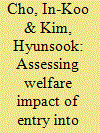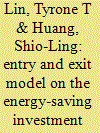| Srl | Item |
| 1 |
ID:
125613


|
|
|
|
|
| Publication |
2013.
|
| Summary/Abstract |
This paper calculates the welfare impact of a new entrant based on the location of entry in the Korean electricity market. We use two different models. One is the optimal fuel mix model to estimate the effect of a new entry in the long run. The other is the variable cost minimization model to assess the contribution of an existing installed private generator in the short run. A specific private generator, which has a cost advantage, saves a substantial amount of system-wide variable costs. We show that the right location for a new entrant can save power generation costs significantly, even if a new entrant does not have a cost advantage.
|
|
|
|
|
|
|
|
|
|
|
|
|
|
|
|
| 2 |
ID:
180849


|
|
|
|
|
| Summary/Abstract |
In developing countries, the penetration of Liquefied Petroleum Gas (LPG) is still high, and hence the entry of Natural Gas (NG) networks coexists with the use of LPG by an important fraction of households. A relevant policy question is whether the degree of horizontal integration between NG and LPG providers has an influence on the level of retail prices. Using self-reported retail prices of the largest LPG provider in Chile during years 2013 and 2014, we estimate that the presence of a competing NG network generates an average decrease of LPG retail prices within the range [-4%,-2%]. This result suggests that the degree of horizontal integration between NG and LPG providers should matter, in particular for policy interventions such as merger control by competition authorities and the granting of concessions for deploying NG networks by sectoral regulators.
|
|
|
|
|
|
|
|
|
|
|
|
|
|
|
|
| 3 |
ID:
094223


|
|
|
|
|
| Publication |
2010.
|
| Summary/Abstract |
This paper presents an improved decision model based on the real options approach presented by for the firms that have not yet established energy-saving equipment under the entry and exit strategies. Furthermore, the proposed model takes account of the inevitable equipment renewal and the occurrence of unexpected events under the Poisson jump process. The timing for terminating an investment when continuous operations of that business are unprofitable is also explored to realize the optimal timing of implementing the energy-saving strategy. The future discounted benefit B follows the geometric Brownian motion with the Poisson jump process and the replacement of investment equipment. A numerical analysis is followed by a sensitivity study of various parameters to better realize their impacts on the entry and exit thresholds. The results show that for the jump case, the higher probability of occurrence of unfavorable events will result in a higher entry threshold and lower exit threshold. Investors are forced to request higher benefit thresholds to cover the higher probability of losses brought by unfavorable events.
|
|
|
|
|
|
|
|
|
|
|
|
|
|
|
|